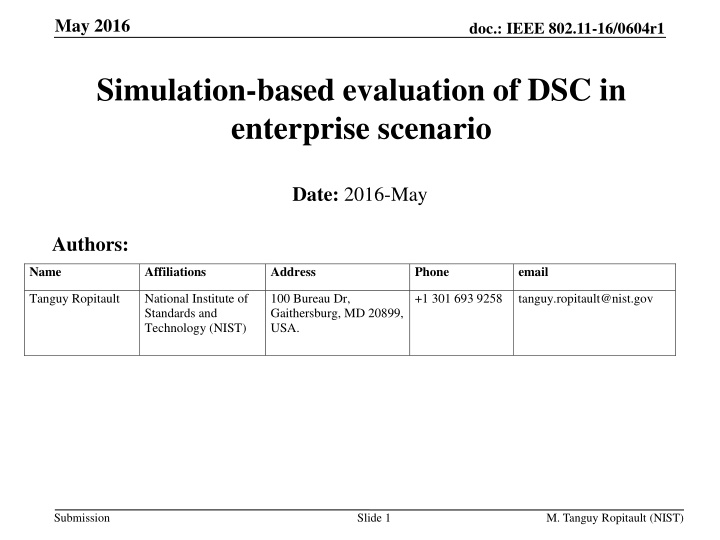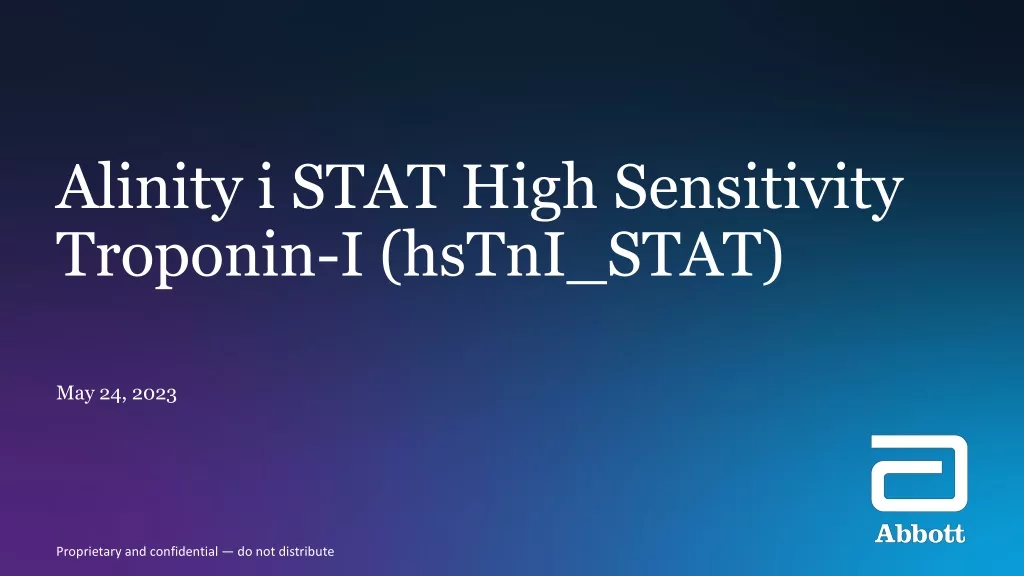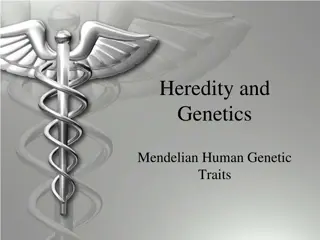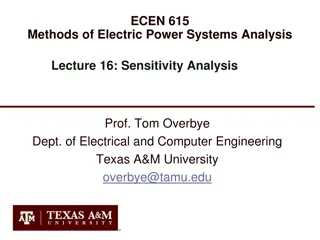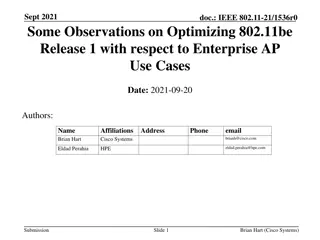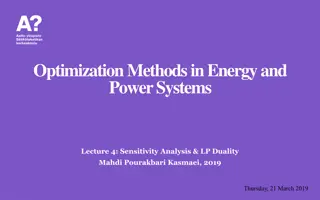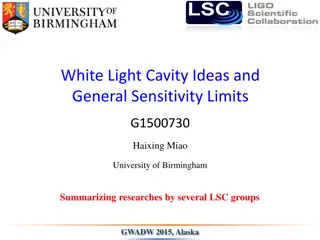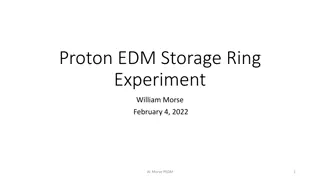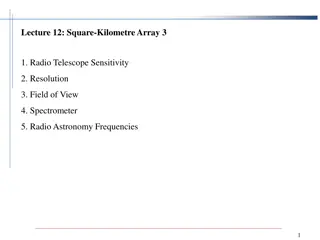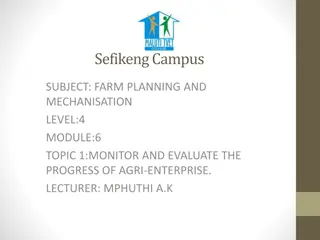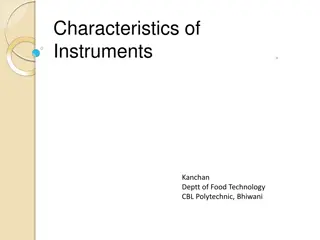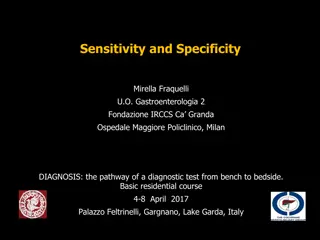Evaluation of Dynamic Sensitivity Control in Enterprise Scenario
Simulation-based evaluation conducted by Tanguy Ropitault from NIST on Dynamic Sensitivity Control (DSC) in an enterprise scenario using IEEE 802.11 standards. The study investigates the impact of DSC on per-user throughput and fairness in dense scenarios. Recommendations on DSC parameters are provided, emphasizing the importance of fairness evaluation when implementing mechanisms to enhance spatial reuse in wireless networks.
Download Presentation

Please find below an Image/Link to download the presentation.
The content on the website is provided AS IS for your information and personal use only. It may not be sold, licensed, or shared on other websites without obtaining consent from the author.If you encounter any issues during the download, it is possible that the publisher has removed the file from their server.
You are allowed to download the files provided on this website for personal or commercial use, subject to the condition that they are used lawfully. All files are the property of their respective owners.
The content on the website is provided AS IS for your information and personal use only. It may not be sold, licensed, or shared on other websites without obtaining consent from the author.
E N D
Presentation Transcript
May 2016 doc.: IEEE 802.11-16/0604r1 Simulation-based evaluation of DSC in enterprise scenario Date: 2016-May Authors: Name Affiliations Address Phone email Tanguy Ropitault National Institute of Standards and Technology (NIST) 100 Bureau Dr, Gaithersburg, MD 20899, USA. +1 301 693 9258 tanguy.ropitault@nist.gov Submission Slide 1 M. Tanguy Ropitault (NIST)
May 2016 doc.: IEEE 802.11-16/0604r1 1. Context Spatial reuse in the SFD The amendment shall include one or more mechanisms to improve spatial reuse by allowing adjustments to one or more of the CCA-ED, 802.11 Signal Detect CCA, OBSS_PD or TXPWR threshold values. The constraints on selecting threshold values are TBD DSC could be used to select these threshold values DSC: Dynamic Sensitivity Control DSC widely studied in TGax WG: DSC increases per-user throughput in dense scenarios [1-12] but what about fairness? More than 20 contributions about DSC since July 2013 and only [12] studies fairness In this submission we, investigate the performance of DSC in enterprise scenario and recommend DSC parameters to use Highlight the importance of fairness study while analyzing mechanisms supposed to increase spatial reuse Submission Slide 2 M. Tanguy Ropitault (NIST)
May 2016 doc.: IEEE 802.11-16/0604r1 2. DSC: The big picture DSC varies CST levels for each station Based on beacons RSSI: R Stations close to the AP have a higher CST AP CST STA1 = R STA2 STA1 CST STA2 = R CST STA1 = R Use of a margin M: CST = R M Help to take into account sudden change in beacon signals AP CST STA2 = R STA2 STA1 CST STA1 = R-M CST STA2 = R-M DSC decreases number of exposed nodes but increases hidden nodes Submission Slide 3 M. Tanguy Ropitault (NIST)
May 2016 doc.: IEEE 802.11-16/0604r1 3. Scenarios and assumptions (1/3) Topology Single floor office building, 8 offices: 4 APs per office i.e. 32 APs 64 cubicles per office Each cubicle has 4 STAs so 8*64*4 = 2048 STAs 2 m 20 m STA1 STA4 20 m 2 m BSS9-12 BSS13-16 BSS24-28 BSS29-32 STA2 STA3 1 Cubicle = 4 STAs BSS1-4 BSS5-8 BSS17-19 BSS20-23 8 offices 1 Office = 64 cubicles Submission Slide 4 M. Tanguy Ropitault (NIST)
May 2016 doc.: IEEE 802.11-16/0604r1 3. Scenarios and assumptions (2/3) Channel allocation: 5GHz (based on [13]) Four 80MHz channels (Ch1 to Ch4) Nine 40Mhz channels (Ch1 to Ch9) Nine 40MHz channels Four 80MHz channels AP Channel 1 2 3 4 5 6 7 8 9 Submission Slide 5 M. Tanguy Ropitault (NIST)
May 2016 doc.: IEEE 802.11-16/0604r1 3. Scenarios and assumptions (3/3) Parameters Values Traffic type UDP CBR uplink transmissions in saturation conditions 1538 Bytes (from SSD) (1544 Bytes in total incl. all overhead) MPDU size Aggregation: 32 MPDUs with 4-byte MPDU delimiter per A- MPDU No A-MSDU Implicit immediate BA Aggregation PPDU of Data frame VHT PPDU (MCS 5, fixed) Guard Interval Short -76 for 80MHz -79 for 40MHz ns-3 CCA Threshold Simulator Submission Slide 6 M. Tanguy Ropitault (NIST)
May 2016 doc.: IEEE 802.11-16/0604r1 4. Metrics used for evaluation Aggregated throughput i.e. sum of STAs UDP throughputs observed at AP level Aggregated Throughput Aggregated Throughput is a good indicator but should not be the only one: what if the throughput gain is obtained only for few nodes at the expense of numberous others? Fairness is needed 400 200 0 Legacy CCA DSC Fairness (Jain s index [14]) - Measure per STA throughput fairness i.e. a Jain s fairness index of 1 means an equal portioning of throughput among STA - Jain s fairness has to be studied conjointly with the aggregated throughput 10 20 50 75 0 75 75 75 Is case 1 really better than case 2? Case 2: Jain s index = 0.70 Case 1: Jain s index = 0.75 Goodput Ratio An illustration of fairness: Goodput Ratio GR STA Goodput Ratio: GRi = #APUDPReceivedi / #STAUDPSenti Submission Slide 7 M. Tanguy Ropitault (NIST)
May 2016 doc.: IEEE 802.11-16/0604r1 5. Four 80MHz channels (1/4) Aggregated Throughput Aggregated Throughput % of throughput increase regarding to Legacy CCA threshold 4500 1 Aggreagted Throughput (Mbps) 4000 0.8 3500 3000 % of throughput increase 0.6 2500 0.4 2000 1500 0.2 1000 0 500 0 -0.2 * -0.4 -0.6 Observations: Margin highly affects DSC performances DSC may allow to increase aggregated throughput compared to Legacy CCA threshold (up to 80%) A DSC margin of 25dBm is giving the best results of all the CST tested for aggregated throughput Conclusions: Margin is a crucial parameter for the DSC as an incorrect margin parametrization could result in negative gain * 80MHz: Legacy CCA threshold = -76dBm Submission Slide 8 M. Tanguy Ropitault (NIST)
May 2016 doc.: IEEE 802.11-16/0604r1 5. Four 80MHz channels (2/4) Fairness: Jain s Fairness Index Jain's fairness index % of Jain's fairness index increase and associated % of throughput increase 1 0.9 1 0.8 0.8 0.7 0.6 0.6 0.5 0.4 0.4 0.2 0.3 0 0.2 0.1 -0.2 0 -0.4 -0.6 % of throughput increase % of Jain's fairness increase Observations: DSC is not always increasing the fairness compared to Legacy CCA threshold ([12] observed the opposite for the residential scenario case whatever the tested margin) A DSC margin of 25 seems the best compromise (same fairness than Legacy and 80% of aggregated throughput increase) Conclusions: DSC may increase fairness and aggregated throughput at the same time Is Jain s fairness representing everything? Let s compare Legacy CCA with DSC m=25 Slide 9 Submission M. Tanguy Ropitault (NIST)
May 2016 doc.: IEEE 802.11-16/0604r1 5. Four 80MHz channels (3/4) Goodput ratio GR: STA Goodput Ratio: GRi = #APUDPReceivedi / #STAUDPSenti -76dBm (One channel) DSC with m=25 (One channel) Observations: Legacy CCA threshold: at least a ratio of 0.10 for each STA DSC: a non-insignificant percentage of STAs has a ratio close to 0 For Legacy STA, the closest STA has a low goodput ratio while it s the opposite for DSC with a margin of 25 Conclusions: DSC could worsen the situation even if aggregated throughput is increased Jain s fairness does not represent completely the fairness as CCA Legacy fairness is the same than DSC m=25 DSC with m=25 is not the best candidate Submission Slide 10 M. Tanguy Ropitault (NIST)
May 2016 doc.: IEEE 802.11-16/0604r1 5. Four 80MHz channels (4/4) Probability Density Function of goodput Ratio PDF of goodput ratio 0.5 0.45 0.4 0.35 0.3 0.25 0.2 0.15 0.1 0.05 0 0.1 0.2 0.3 0.4 0.5 0.6 0.7 0.8 0.9 1 Legacy m=20 m=25 DSC with m=20 (One channel) Observations: Legacy CCA: No STA has a goodput ratio less than 0.10 DSC m=20 (best Jain Fairness): 45% of STA has a goodput ratio of 0.7 DSC m=25: 12% of STAs has a goodput ratio less than 0.1 Conclusions: A DSC margin of 20dB is recommended for the four 80MHz scenario DSC must be studied regarding both to fairness and goodput, not only for aggregated throughput Slide 11 Submission M. Tanguy Ropitault (NIST)
May 2016 doc.: IEEE 802.11-16/0604r1 6. Nine 40MHz channel (1/3) Aggregated throughput Aggregated Throughput % of throughput increase regarding to Legacy CCA threshold 2500 Aggregated Throughput (Mbps) 0.6 2000 0.4 1500 0.2 1000 0 500 -0.2 -0.4 0 * -0.6 -0.8 Observations: Same behavior than for four 80Mhz Channel: Margin highly influences throughput A DSC margin of -35dBm is giving the best results of all the tested margins for aggregated throughput * 40MHz: Legacy CCA threshold = -79dBm Submission Slide 12 M. Tanguy Ropitault (NIST)
May 2016 doc.: IEEE 802.11-16/0604r1 6. Nine 40MHz channel (2/3) Fairness: Jain s Fairness Index % of Jain's fairness index increase and associated % of throughput increase Jain Fairness 0.8 0.9 0.6 0.8 0.7 0.4 0.6 0.2 0.5 0.4 0 0.3 -0.2 0.2 0.1 -0.4 0 % of throughput increase -0.6 % of Jain's index increase -0.8 Observations: DSC could increase fairness compared to CCA Legacy Threshold Even if DSC with 35 margin is giving the best aggregated throughput, it does not seem to be the best candidate regarding to Jain s fairness (m=25 seems to be as it increases both fairness and throughput) Submission Slide 13 M. Tanguy Ropitault (NIST)
May 2016 doc.: IEEE 802.11-16/0604r1 6. Nine 40MHz channels (3/3) Probability Density Function of goodput Ratio PDF of goodput ratio 0.7 0.6 0.5 0.4 0.3 0.2 0.1 0 0.1 0.2 0.3 0.4 0.5 0.6 0.7 0.8 0.9 1 Legacy CCA DSC m=25 DSC m=35 Observations: Legacy CCA: 23% of STAs has a goodput ratio less than 0.10 DSC m=25 (best Jain Fairness): 65% of STA has a goodput ratio of 0.3. No STA has a ratio less than 0.1 DSC m=35: 40% of STAs has a goodput ratio less than 0.1 Conclusions: DSC must be studied regarding to fairness and goodput, not only for aggregated throughput A DSC margin of 25dB is recommended for the nine 40MHz scenario Submission Slide 14 M. Tanguy Ropitault (NIST)
May 2016 doc.: IEEE 802.11-16/0604r1 7. Conclusions/next steps DSC and more generally SR mechanisms must be studied not only regarding to aggregated throughput but also for STAs fairness and goodput As stated in the SFD, include one or more mechanisms to improve spatial reuse by allowing adjustments to one or more of the CCA-ED, 802.11 Signal Detect CCA, OBSS_PD or TXPWR threshold values. The constraints on selecting threshold values are TBD DSC scheme provides improvements in throughput but not always regarding to fairness and goodput. However, there is still a DSC margin value that allows increase in fairness, goodput and aggregated throughput (-20dB for four 80MHz channels and -25dB for nine 40MHz channels). DSC is a good candidate. DSC parametrization is of crucial importance DSC draft proposal [15]: A variety of methods could be used for the AP to determine these values (i.e. DSC algorithm parameter), either by pre-setting them based upon the location and environment of the network, or by a learning process The learning process should be investigated cause poor static DSC parameters configuration could lead to worse results than the Legacy CCA Submission Slide 15 M. Tanguy Ropitault (NIST)
JMay 2016 doc.: IEEE 802.11-16/0604r1 8. References 1) Graham Smith, DSP Group, 11-13-1290-01 Dynamic Sensitivity Control for HEW 2) Graham Smith, DSP Group, 11-13-1487-02 Dense Apartment Complex Capacity Improvements with Channel selection and Dynamic Sensitivity Control 3) Graham Smith, DSP Group, 11-13-1489-05 Airport Capacity Analysis 4) Graham Smith, DSP Group, 11-14-0045-02 E-Education Analysis 5) Graham Smith, DSP Group, 11-14-0058-01 Pico Cell Use Case Analysis 6) Graham Smith, DSP Group, 11-14-0294-02 Dynamic Sensitivity Control Channel Selection and Legacy Sharing 7) Graham Smith, DSP Group, 11-14-0365-01 Dynamic Sensitivity Control Implementation 8) Graham Smith, DSP Group, 11-14-0328-02 Dense Apartment Complex Throughput Calculations 9) Graham Smith, DSP Group, 11-14-0779-00 Dynamic Sensitivity Control Practical Usage 10) Imad Jamil, Orange, 11-14-0523-00 Mac Simulation Results for DSC and TPC 11) William Carney, Sony, 11-14-0854-00 DSC and Legacy Coexistence 12) Shahwaiz Afaqui, 11-15-0027-1 Simulation-based evaluation of DSC in residential scenario 13) Graham Smith, 11-15-0548-1 Enterprise scenario and DSC 14) J. R., Fairness: How to measure quantitatively? 15) Graham Smith, DSP Group, 11-16-0310-1-00 CCA Proposal DSC Text Submission Slide 16 M. Tanguy Ropitault (NIST)
